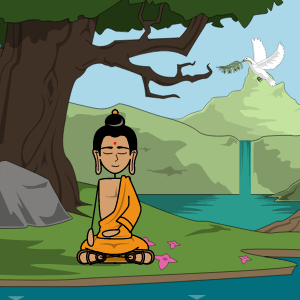Ancient India Biography Activity Storyboard

You can find this storyboard in the following articles and resources:

Ancient India: Teacher Guide & Activities
By Liane Hicks
People have been living on the Indian subcontinent for 250,000 years! Currently there are over 1.3 billion people living in the Republic of India, making it the second most populous country in the world next to China. Learn more with Storyboard That!

Buddhism: Origins & History
By Liane Hicks
Buddhism is practiced by over 500 million people worldwide and is the world's fourth largest religion. Buddhism is about 2,500 years old and began in the 6th century based on the teachings of the Buddha. It is a religion centered on peace and tranquility and the importance of leading a moral and good life.
'
Storyboard Description
Create a biography of an important person or event during the time of Ancient India!
Storyboard Text
- Early Life and Becoming KingAshoka's grandfather, Chandragupta Maurya, came from humble beginnings before overthrowing the Nanda Empire in India and creating the Mauryan Empire. This empire expanded to become the largest empire in ancient India. It included most of modern day India, Bangladesh, Nepal, Pakistan, and Afghanistan, which at the time was controlled by the Greeks.Chandragupta gave his throne to his son, Bindusara, who ruled from 297 BCE until his death in 272 BCE. Ashoka was not in line for the throne when his father died. However, he seized power from his brother and a four-year-long bloody civil war ensued. Ashoka killed all opposition to his rule. He became king in 268 BCE. His ruthlessness earned him the name Ashoka the Fierce.
- King Ashoka the GreatMauryan Empire(Ruled 268 BCE - 232 BCE)
- Ashoka the GreatArchitecture flourished under Ashoka's rule. Stone sculptures were crafted, most famously the Lion Capital at Sarnath. He built hospitals, botanical gardens, roads, wells, and other helpful infrastructure throughout his empire. However, while he no longer used his armies for conquest, he did not return any of the land he conquered and he still kept a large army, had strict laws, and permitted slavery and executions.
- Converting to Buddhism and Ashoka's EdictsAfter the conquer of Kalinga, Ashoka changed his ways, rejected violence, and embraced Buddhism. He promoted the tenets of peace, love, and non-violence, respecting all living things. He even became a vegetarian and banned animal cruelty. Ashoka spread his message by having edicts carved and placed throughout his Empire. The edicts instructed his people on how to live with kindness, respect, and tolerance for all.
- LegacyAfter Ashoka's death in 232 BCE, the Mauryan Empire went into decline. Ashoka the Great continues to be honored in India today. Symbols of his rule are everywhere, like the Wheel of the Law (the Ashoka Chakra) on the Indian flag and the Lions at Sarnath on money (rupees). Ashoka is remembered for turning to peace, uniting India, and spreading Buddhism throughout India and abroad.
- Ashoka the FierceWhile the Mauryan Empire was already massive. Ashoka wanted to conquer more territory, and he did so violently. Kalinga in southeast India, rich in resources and trading ports along the Indian Ocean, was one such conquest. In 261 BCE, Ashoka sent his armies to conquer Kalinga. The Mauryan Army was the largest force of its time with 600,000 foot soldiers, 30,000 cavalry, and 9,000 war elephants! The Kalingans were crushed with about 100,000 dead and 150,000 taken as prisoners. When he saw the devastation he had caused, Ashoka the Fierce had a change of heart.
Over 30 Million Storyboards Created
No Downloads, No Credit Card, and No Login Needed to Try!












